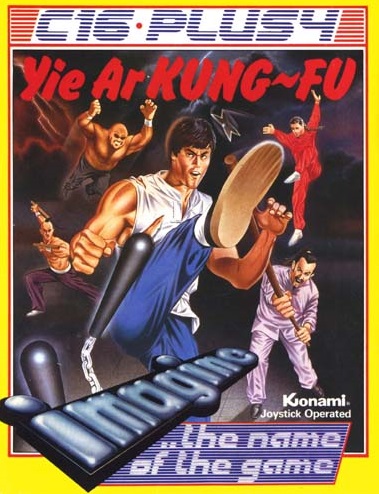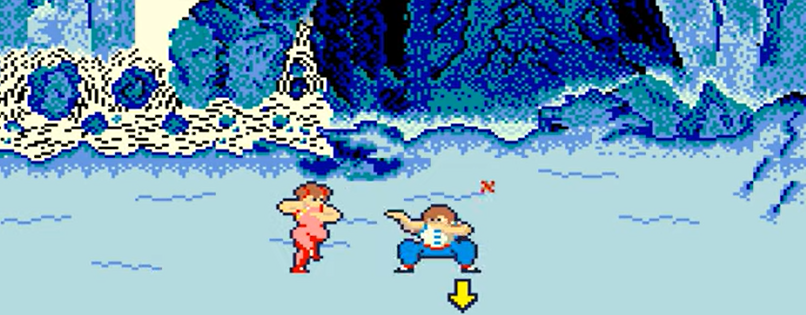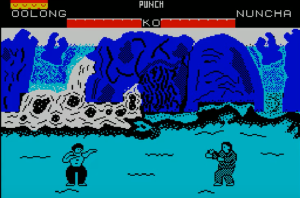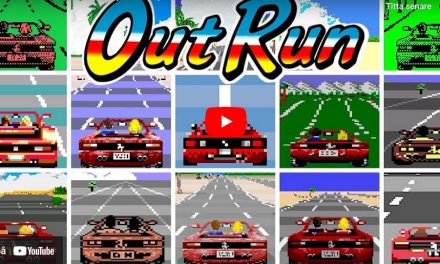
The awesome art on the cassette case. Brilliant.
One second hand computer, and a bag with 550 games…
It came bundled with my first home computer—a small black marvel called the Sinclair Spectrum 48k. I bought it as a gift to myself, paid for with my weekly allowance and spare change earned from extra shifts at a local factory. In my opinion, it was quite expensive; at around $500, it made a dent in my savings account. And it came with a bag of cassettes, with more than 500 games. But it was pure joy: loading Konamis buttkincking masterpiece Yie Ar Kung-Fu. Then connecting the Wico Red Ball joystick, and releasing some roundhouse kicks at the opponents on the 26-inch TV.
The 1985 arcade version when new was imho the best arcade fighting game ever made
Before I bought the mighty Spectrum 48k, I had played the arcade version at the local pizzeria. I loved the colors, the graphic design, and the gameplay. I was fully aware of the difference in graphics between the arcade machine and the little Spectrum, but that didn’t matter. Now, 38 years later, the Spectrum version looks quite dated. However, in 1986, this game was stunningly gorgeous—both in its gameplay and the beautiful cassette case. I cherished it. And having friends over, playing it was a blast.
Now let’s dive into the world of this classic game, its development, characters, legacy, and the sequel that followed.
Gameplay and development
“Yie Ar Kung-Fu” introduced gamers to Mr Oolong. A martial artist on a quest to become the grandmaster of Kung-Fu by defeating a series of opponents, each with their unique fighting styles and weapons. Developed by Konami, the game stood out for its simplistic yet challenging mechanics, offering players a variety of attacks and techniques to master. The game’s fluid combat system and distinctive character playstyles were revolutionary, providing an engaging and dynamic arcade experience.
Characters and weapons
The cast of “Yie Ar Kung-Fu” included a diverse array of enemies, such as the nunchaku-wielding “Nuncha,” (in his yellow outfit, clearly a homage to Mr Roper played by John Saxon in the classic movie Enter the Dragon), the swift and deadly “Fan,” and the bo staff expert “Pole.” Each character brought their unique weapon and fighting style to the fray, challenging players to adapt their strategies. Oolong himself was a homage to classic martial arts heroes, embodying the virtues of discipline and strength.The
Heavyly inspired from Hong Kong cinema
The game drew heavy inspiration from the martial arts films of Hong Kong, mirroring the action-packed sequences and the valorous tales of martial artists. This connection not only enriched the game’s narrative but also attracted fans of the genre, offering them a chance to live out their cinematic fantasies.

This screen is taken from the arcade version. And when new, it was gorgeous. The best arcade fighting game of the 80´s?
Ports and versions of the best arcade fighting game of the 80´s
Yie Ar Kung-Fu saw various ports to home computers and consoles, including the Commodore 64, ZX Spectrum, and the MSX. Each version attempted to capture the essence of the arcade original, with varying degrees of success. Among these, the MSX version is often lauded for its faithfulness to the arcade experience, offering crisp graphics and responsive controls.
Reviews and legacy
Upon release, Yie Ar Kung-Fu received acclaim for its innovative approach to the fighting game genre. It was praised for its challenging gameplay, variety of characters, and its role in laying the groundwork for future fighting games. The game is considered a pioneer, influencing titles such as “Street Fighter” and “Mortal Kombat,” which would further define and expand the genre.
Influences on other games

The not that amazing Sinclair Spectrum graphcs. But it was a blast playing it!
By introducing a roster of fighters each with unique styles, “Yie Ar Kung-Fu” akathe best arcade fighting game of the 80´s set a template for character diversity in fighting games. Its emphasis on mastering different techniques against varied opponents influenced the development of deeper, more strategic fighting games.
Competitors in the Genre
In the mid-80s, the fighting game genre was still in its infancy. “Karate Champ,” another arcade game released around the same time, was among Yie Ar Kung-Fu’s main competitors. However, Yie Ar Kung-Fu’s detailed character design and dynamic combat system set it apart, helping to cement its place in gaming history.
The disappointing sequel: Yie Ar Kung-Fu II – Clearly not the best arcade fighting game…
Yie Ar Kung-Fu II aimed to build on the original’s success by introducing new characters, arenas, and an updated combat system. Since I loved the first game, I had to get the sequel. Unfortunately, I found it to be quite a disappointment. In my opinion, it failed to deliver the charm and gameplay experience of its predecessor. When it was released, five of my best friends had also bought their Spectrum computers, and I remember none of them being even slightly impressed with Yie Ar Kung-Fu II.
The Yie Ar Kung-Fu conclusion – The best arcade fighting game in the 80´s
Yie Ar Kung-Fu remains a revered title in the annals of video game history, a testament to its innovation and influence on the fighting game genre. Its legacy is seen in the diversity of characters and combat systems that have become staples in the genre. As we look back on this classic, its spirit lives on in the countless fighting games that have followed, continuing to inspire developers and gamers alike.
Want to play Yie Ar Kung-Fu online? Then visit KBH Games!
Thank you for visiting LegandsAndNostalgia.com



